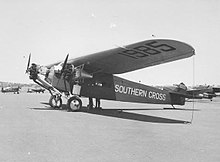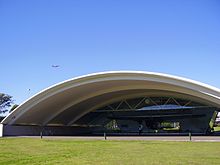Charles Kingsford Smith: Difference between revisions
Apparition11 (talk | contribs) m Reverted edits by 202.7.74.162 to last version by 60.242.158.99 (HG) |
No edit summary |
||
| Line 1: | Line 1: | ||
{{Infobox |
{{Infobox sdadjdshfsjdfsdafads |
||
|name= Sir Charles Kingsford Smith |
|||
|lived= 9 February 1897 — 8 November 1935 |
|||
|image=CEKSmith.jpg |
|||
|image size=200px |
|||
|caption= Kingsford Smith in his flying gear |
|||
|full name= Sir Charles Edward Kingsford Smith |
|||
|place of birth= [[Hamilton, Queensland]] |
|||
|nationality= [[Australia]]n |
|||
|place of death= Sea off [[Burma]] |
|||
|cause of death= Disappeared during flight |
|||
|spouse= |
|spouse= |
||
|relatives= |
|relatives= |
||
Revision as of 03:58, 16 October 2008
Template:Infobox sdadjdshfsjdfsdafads Sir Charles Edward Kingsford Smith MC, AFC (9 February 1897 - 8 November 1935), often called Charles Kingsford Smith, or by his nickname Smithy, was a well-known early Australian aviator. In 1928, he made the first trans-Pacific flight from the United States to Australia. He also made the first non-stop crossing of the Australian mainland, the first flights between Australia and New Zealand, and the first eastward Pacific crossing from Australia to the United States. He also made a flight from Australia to London, and set a new record of 10.5 days.
Early life
Kingsford Smith was born in Hamilton (a suburb of Brisbane), Queensland, Australia, and was one of seven children. From 1903 to 1907, he and his family lived in Vancouver, Canada.
On 2 January 1907 young Charlie Smith was rescued from certain drowning at Sydney’s famous Bondi Beach by bathers who, just seven weeks later, were responsible for founding the world’s first official surf life saving group at Bondi Beach on 21 February 1907, at a meeting held at the Royal Hotel Bondi Beach. [1]
Upon returning to Australia, he attended St Andrew's Cathedral School in Sydney where he was a treble chorister in the cathedral choir. He then studied electrical engineering at Sydney Technical College (now known as Sydney Technical High School).
World War I and early flying experience
At 16 he became an engineering apprentice with the Colonial Sugar Refining Company. After that, he enlisted for duty in the armed services in 1915 and served at Gallipoli. Initially, he performed duty as a motorcycle despatch rider, before transferring to the Royal Flying Corps, earning his wings in 1917.
Kingsford Smith was hospitalized in August 1917 after being shot down and receiving injuries which required a large part of his left foot to be amputated. For his gallantry in battle, he was awarded the Military Cross. As his recovery was predicted to be lengthy, Kingsford Smith was permitted to take leave in Australia where he visited his parents. Returning to England, Kingsford Smith was assigned to instructor duties and promoted to captain.
After the war, Kingsford Smith worked as a barnstormer in the United States before returning to Australia in 1921.[2] He did the same in Australia and also flew airmail services, and began to plan his record-breaking flight across the Pacific. [3] Applying for a commercial pilot's licence on 2 June 1921 (in which he gave his name as 'Charles Edward Kingsford-Smith')[4], he became one of Australia's first airline pilots when he was chosen by Norman Brearley to fly for the newly formed West Australian Airways.
1928 - Trans-Pacific flight

Kingsford Smith and Charles Ulm arrived in the United States and began to search for an aircraft. From the famed Australian polar explorer, Sir Hubert Wilkins, they purchased and equipped a Fokker F.VII/3m monoplane, which they named the Southern Cross.[5]
At 8:54 am on 31 May 1928, [5] Kingsford Smith and his crew left Oakland, California to make the first trans-Pacific flight to Australia. The flight was in three stages. The first (from Oakland to Hawaii) was 2,400 miles, took 27 hours 25 minutes and was uneventful. They then flew to Suva, Fiji 3,100 miles away, taking 34 hours 30 minutes. This was the toughest part of the journey as they flew through a massive lightning storm near the equator. They then flew on to Brisbane in 20 hours, where they landed on 9 June after approximately 7,400 miles total flight. On arrival, Kingsford Smith was met by a huge crowd of 25,000 at Eagle Farm Airport, and was feted as a hero [6][7].[8] Australian aviator Charles Ulm was the relief pilot, and the other two crew members were Americans James Warner and Captain Harry Lyon (who were the radio operator, navigator and engineer).
Australian National Airways
'Coffee Royal' incident
On the 31st of March 1929, enroute from Sydney to England, the Southern Cross with Kingsford Smith at the helm made an emergency landing on a mudflat in the Kimberley region of northern Western Australia. The Southern Cross was found and rescued after a fortnight's searching, but two men — Keith Anderson and Bob Hitchcock, in their Westland Widgeon Kookaburra — crash landed and died of thirst and exposure while on their way to help with the search. Despite Kingsford Smith being exonerated by an official enquiry, many sections of the media and public felt that the forced landing, dubbed the 'Coffee Royal' incident after the brew of coffee and brandy which the crew had drunk while awaiting rescue, had been a publicity stunt and that Kingsford Smith was responsible for the deaths. His reputation within Australia never fully recovered during his lifetime.
Later flights
In 1930, he competed in an England to Australia air race, and, flying solo, won the event.
In 1931 he purchased an Avro Avian he named the Southern Cross Minor, to attempt an Australia to England flight. He later sold the aircraft to Captain W.N. "Bill" Lancaster who vanished April 11, 1933 over the Sahara Desert; Lancaster's remains were not found until 1962. The wreck of the Southern Cross Minor is now in the Queensland Museum.[9] Also in 1931, Smith began developing the Southern Cross automobile as a side project.
In 1933 Seven Mile Beach was used by Sir Charles Kingsford Smith as the runway for the first commercial flight between Australia and New Zealand.
Disappearance
It was during another long-distance flight that Kingsford Smith met his end. Once again flying from England to Australia, he and his co-pilot Tommy Pethybridge departed Allahabad, India on the evening of 7 November 1935 for a leg to Singapore, flying in the Lockheed Altair Lady Southern Cross. The aircraft did not arrive at its destination. Eighteen months later, in May 1937, the starboard undercarriage leg from the Altair was discovered by fishermen on an island south of Burma. The remains of the crew and the rest of the aircraft have never been located.
Legacy

The major airport of Sydney, located in the suburb of Mascot was named Kingsford Smith International Airport in his honour. A federal electorate, for the parliament of Australia, which encompasses the airport is called Kingsford Smith. A suburb of Sydney is named Kingsford.
His aircraft, the Southern Cross, is now preserved and displayed in a purpose-built memorial at the International Terminal at Brisbane Airport. Kingsford Smith Drive in Brisbane passes through the suburb of his birth, Hamilton, with Kingsford Smith Drive in the suburb of Belconnen, Canberra also bearing his name.
He was also pictured on the Australian $20 paper note (in circulation from 1966 until 1994, when the $20 polymer note was introduced to replace it) to honour his contribution to aviation and his accomplishments during his life.
He was also depicted on the Australian one-dollar coin of 1997, the centenary of his birth.
Kingsford Smith was knighted in 1932 for services to aviation and later was appointed honorary Air Commodore of the Royal Australian Air Force.
Albert Park in Suva, where he landed on the trans-Pacific flight, now contains the Kingsford Smith Pavilion.
Tributes to Charles Kingsford Smith
- The 1946 Australian film "Smithy", with Ron Randell as Charles Kingsford Smith and John Tate as Charles Ulm.[11]
- The 1985 Australian television mini-series "A Thousand Skies", with John Walton as Charles Kingsford Smith and Andrew Clarke as Charles Ulm.[12]
- Bill Bryson goes in detail on C K Smith's life in his book "In a sunburned country".
References
- ^ Bondi Surf Club
- ^ Fifty Australians
- ^ Charles Kingsford Smith biography Ace Pilots
- ^ National Archives of Australia - Application for pilot's licence - Charles Edward Kingsford-Smith
- ^ a b 7.30 report story about Charles Ulm
- ^ History of Eagle Farm (Our Brisbane)
- ^ Photo of Southern Cross, and welcoming crowd, at Eagle Farm on June 9, 1928 (National Archives of Australia)
- ^ Magnificent Machines - Home-grown Legends (Sydney Morning Herald)
- ^ The Pioneers - Chubbie Miller
- ^ Famous Freemasons
- ^ Smithy (1946) at IMDb
- ^ "A Thousand Skies" (1985) at IMDb
Serle, Percival (1949). "Smith, Charles Edward Kingsford". Dictionary of Australian Biography. Sydney: Angus & Robertson.
External links
- The Pioneers - Charles Kingsford Smith
- Charles Kingsford Smith biography Ace Pilots
- Sir Charles Kingsford Smith Australian Heroes
- Charles Kingsford Smith about the Tasman flight
- Charles Kingsford Smith (includes photos of Sir Charles Kingsford Smith and his aeroplane, the Southern Cross)
- Sir Charles Kingsford Smith Sound Recordings and Newsreels
- Austin Byrne and the Kingsford Smith Southern Cross Memoria Memorial
- Sir Charles Kingsford Smith at the National Film and Sound Archive
